Sedum sinforosanum (Crassulaceae), a new species
from the state of Chihuahua, México

1. Barranca de Sinforosa, habitat of Sedum sinforosanum.
Abstract: Sedum sinforosanum is a new sedum from the Barranca de Sinforosa, Chihuahua, northwestern Mexico. It belongs to subgenus Sedum L. because of its free petals and sepals and is generally glabrous. It is distinguished from Sedum suaveolens by being many-branched, with smaller rosy-colored rosettes, the absence of bracteoles on the pedicels, petals not circinate, truncate, nectaries bright yellow, ovary pink and with straight styles.
Resumen: Se describe e ilustra una nueva especie del género Sedum en la Barranca de Sinforosa, estado de Chihuahua, noroeste de México. Sedum sinforosanum se ubica en el subgénero Sedum por sus pétalos y sépalos libres, generalmente glabros, se distingue de S. suaveolens por sus rosetas de menor tamaño evidentemente rosadas, muy cespitosa, ausencia de bractéolas en los pedicelos, pétalos no enrollados, así como nectarios truncados de amarillo intenso, ovario rosado y estilos rectos.
Introduction
In 2009 Julia Etter & Martin Kristen received a plant from Jean-Marc Chalet that they tentatively identified as Sedum aff. suaveolens, although Chalet’s locality was at a distance of about 180 km NNW as the crow flies from the type locality (and so far only known locality) near Topia.
In December 2010 Etter & Kristen, collaborators with the Instituto de Biología, Universidad Nacional Autónoma de México (UNAM) and members of theSociedad Mexicana de Cactología, A.C., went on an exploratory field-trip to locate the long lost Echeveria tobarensis Berger (Etter & Kristen, 2011). On this same trip they went on to Topia in the state of Durango to take pictures of Sedum suaveolens. This species was discovered in 1976 by Myron Kimnach and
Hernando Sánchez Mejorada on shaded cliffs of the canyon that lies about 500 m below Topia, near Los Molinos (Kimnach, 1978).
One of the next stops on their trip was Guachochi, Chihuahua. From here they followed Chalet’s directions to Agua Blanca along the newly constructed paved highway. From Agua Blanca they continued on a dirt road towards Cumbres de Guerachi. A spectacular switchback road drops from 2100 m at the beginning of the descent into the 1300 m deep canyon. With Chalet’s GPS position the locality was easy to find. The new species grew with Agave vilmoriniana on a shady and difficult-to-access cliff.
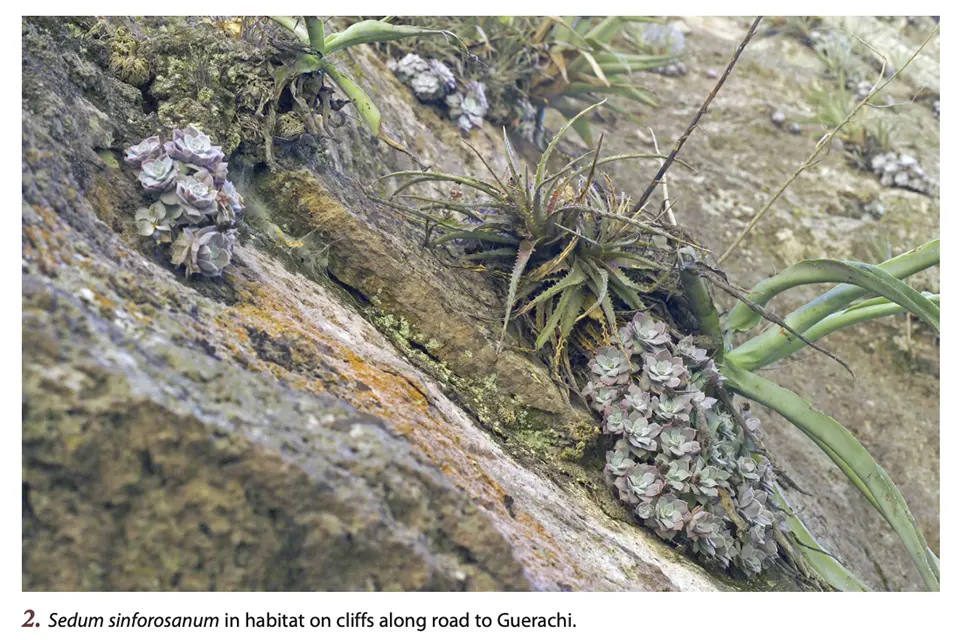
The next day they went to the viewpoint platform of the Barranca Sinforosa south of Guerachi (Figs. 1 & 2). They hiked
down to the waterfall called ‘La Rosalinda’ at 1913 m altitude, where they found clusters of the same species on shaded cliffs above the small waterfall. Back up at the suspension bridge they discovered another small population on a rock just below the bridge. In the dry moss they also found Graptopetalum filiferum and a presumed hybrid between Sedum sinforosanum und Graptopetalum filiferum (Fig. 3). This locality was at 2205 m, a little over 400 meters higher than the plants at the type locality and also in a somehow different habitat with pines and oak trees.
This taxon from the Barranca de Sinforosa, Chihuahua, is allied with Sedum suaveolens Kimnach from the Barranca de Topia, Durango. We believe it deserves the status of a new species.
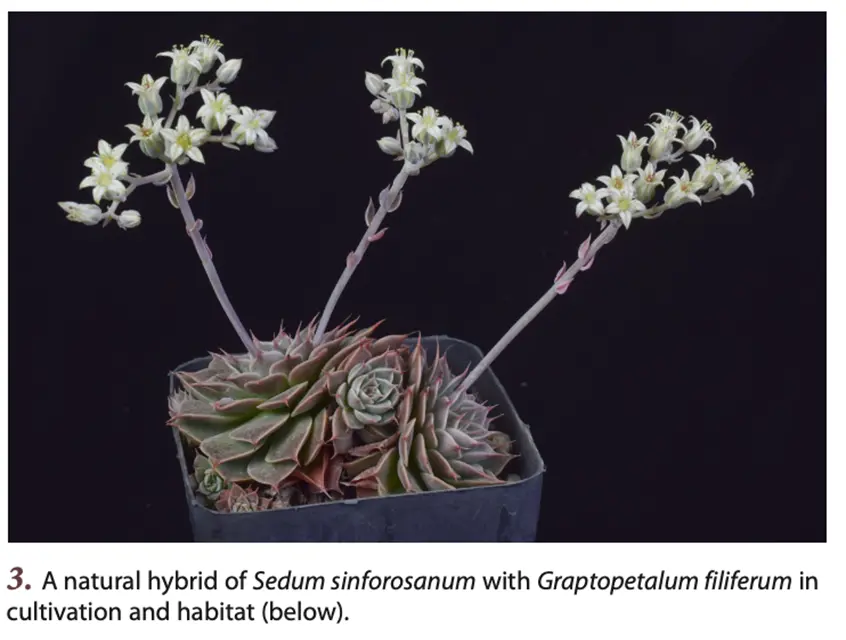
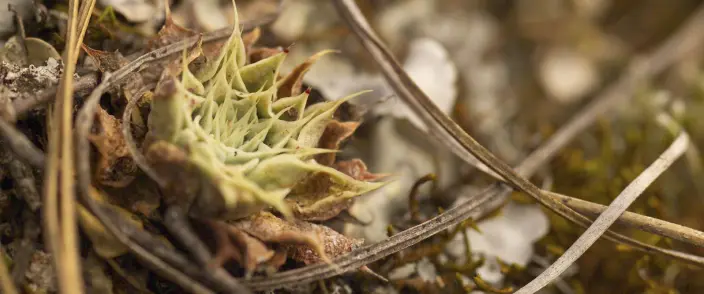
Sedum sinforosanum Reyes, Etter & Kristen species nova.
Diagnosis: Sedo suaveolente simile sed valde caespitosum (vs. aliquot caespitosum), rosulis roseis 9 cm diam. (vs. caeruleas, 16 cm diam.), pedicellis usque ad 4 mm longis (vs. usque ad 7 mm), petalis recurvatis (vs. circinatos), gynoecio roseo (vs.album), nectariis luteis (vs. albos) differt.
Plant a perennial herb, glabrous, caespitose (Fig.2). Roots fibrous. Stems 3–5 cm long, ca. 1.2 cm in diameter, offshoots with stems up to 8 cm long and ca. 5 mm in diameter. Rosettes 6.5–9 cm in diameter. Leaves rose-colored, obovate, 2.5–3.5 cm long, 1.5–2 cm wide, expanding or ascending, pruinose, margin markedly pink, apex cuspidate (Fig. 4). Floral stems subapical, 2–4 per rosette, green to pink, pruinose, 7–9 cm long, 1.8–2.5 mm in diameter. Inflorescence cymose, bracts lanceolate, 6–9 mm long, 3.5–5 mm wide, pruinose, slightly pink, 3–4 cincinni, with 4–7 flowers per peduncle (Fig. 5). Pedicels 3.5–4 mm long, ca. 1.5 mm in diameter, pruinose. Sepals 5, unequal, appressed, ascending, lanceolate, 4.5–5.6 mm long, 1.7–2.5 mm wide, green-reddish, pruinose.
Petals 5, free, white with a slight pink tinge, 7.5–8.5 mm long, 3–3.5 mm wide, apex reddish, retrorse (Fig. 6). Androecium: filaments white, with 5 antisepalous stamens, 5.4–5.6 mm long, epipetalous stamens 4.5–5 mm long, hyaline, thecae purple, pollen yellow. Gynoecium yellowish to pink, semi-globose, 2.2–2.7 mm thick, carpels free, style greenish, ca. 2 mm long. Nectaries quadrangular, yellow, ca. 1 mm wide. (Fig.7).
Type: Mexico, Chihuahua, municipality of Guachochi, Barranca de Sinforosa, along road to Río Guerachi, 1841 m, December 16, 2010. Julia Etter & Martin Kristen 3128 (Holotype: MEXU).
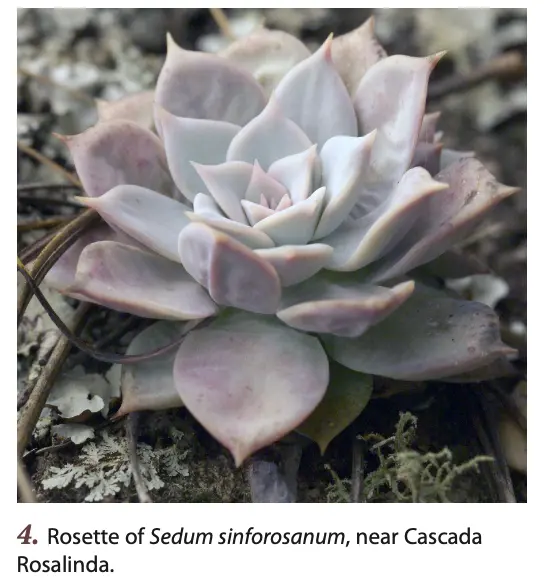
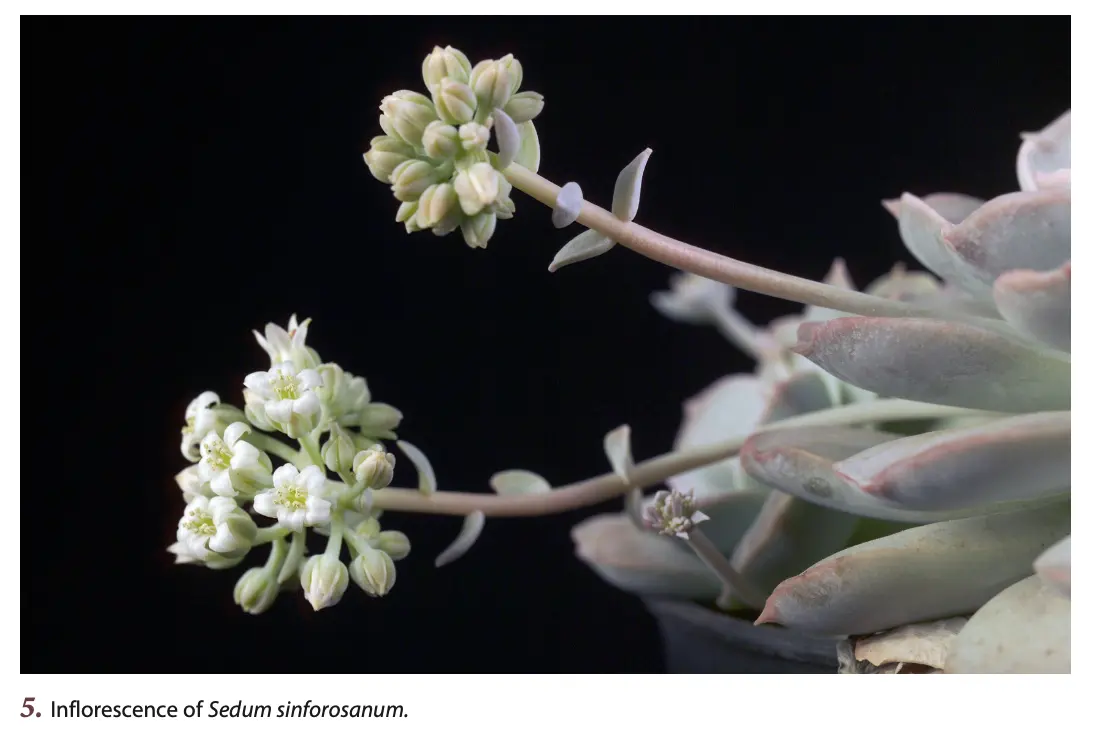
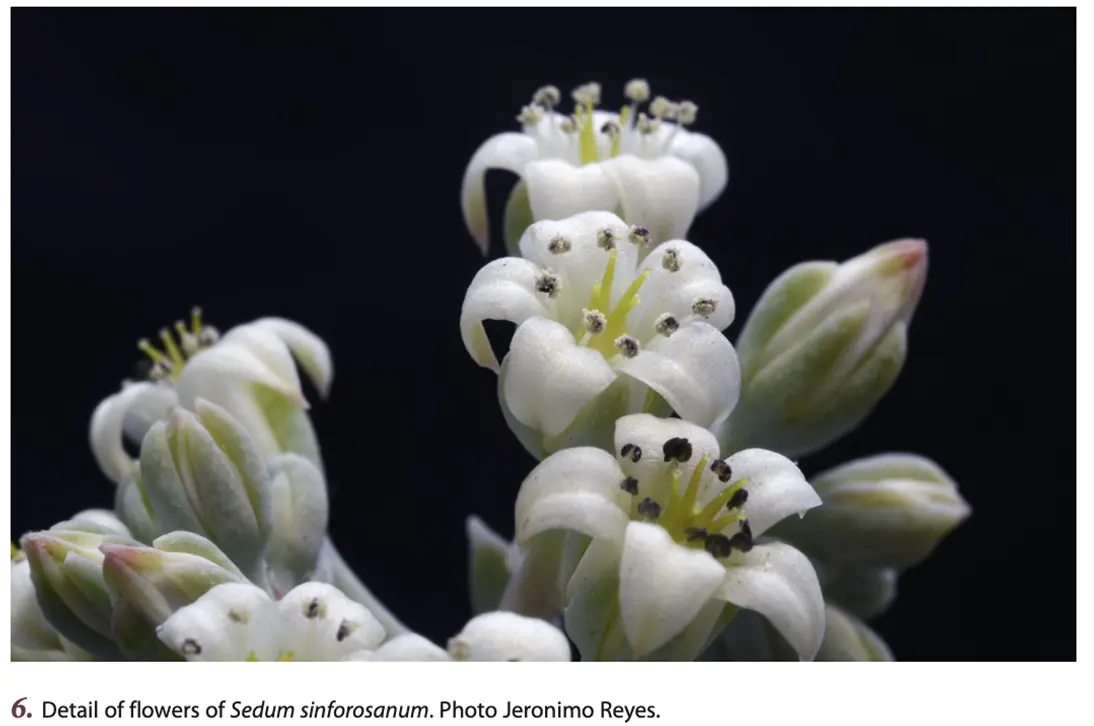
Flowering season: In cultivation, this species flowers from April to July.
Distribution and habitat: At the type locality Sedum sinforosanum grows in desert scrub with Yucca madrensis Gentry, Agave vilmoriniana Berger, and Echinocereus chaletii W. Rischer. Near the Cascada Rosalinda the species grows with Agave filifera subsp. multifilifera (Gentry) Ullrich, A. shrevei subsp. magna Gentry, Mammillaria senilis Lodd. ex Salm-Dyck, and Graptopetalum filiferum (Watson) Whitehead. It was found at the suspension bridge in pine and oak forest, and near the waterfall in a tropical deciduous forest.
Etymology: The specific epithet refers to the Barranca de Sinforosa.
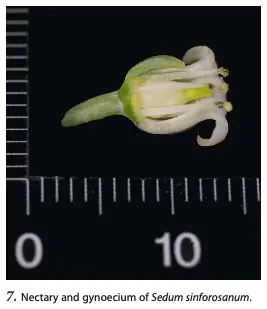
DISCUSSION
It is surprising that at a relatively touristy and readily accessible place like the Barranca Sinforosa, and not far from the viewing platform, a species of Sedum could be found that had not been seen or studied before. We assume that more localities of this new species will be found in the 24 km distance between the Guerachi switchbacks at the southwest end of the plateau surrounding Guachochi and the Rosalinda waterfall, although access will be difficult due to the lack of roads and the steep terrain with many cliffs.
This new species is related to Sedum suaveolens with which it shares characters like the cymose inflorescence and white, odoriferous flowers. It differs in leaf color, the shape of the petals and the caespitose growing habit (see Table 1).
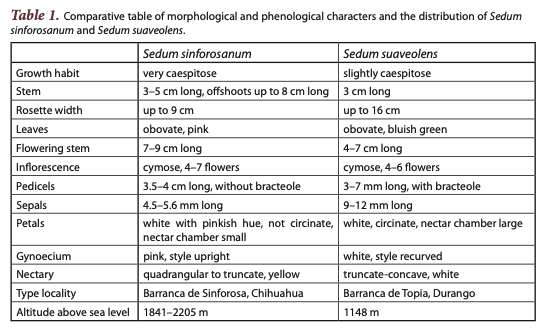
It is possible that Sedum suaveolens and S. sinforosanum are close relatives of S. craigii Clausen from the Barranca del Cobre because of their short, cymose inflorescences with white, odoriferous flowers, as is mentioned in the first description of S. suaveolens (Kimnach, 1978). The placement of these species is still uncertain. They have been placed in Graptopetalum for their overall appearance or they may be of hybrid origin (Clausen, 1981). In a molecular analysis of the genus Graptopetalum it was recognized that monophyly does not exist in the genus and that at least three subclades are grouped together, among them Graptopetalum bellum (Tacitus bellus) (Moran & Meyrán) D.R. Hunt, G. bartramii Rose, G. craigii (Sedum craigii) Clausen, and G. suaveolens (Sedum suaveolens) (Kimnach) Clausen. They all occur in the same geographical region but differ noticeably in morphology of the floral structures, which apparently offers more reliable data for phylogeny (Acevedo-Rosas, et al. 2004). The complex system of mountains in this region, the product of intense geological activity during the Cretaceous and Cenozoic periods (Reyes, González & Kristen, 2012), resulted in the geographical isolation of these species.
ACKNOWLEDGMENTS
The authors thank Myron Kimnach for his valuable comments. The second authors thank Jean-Marc Chalet for bringing this species to their attention and for his companionship on several field-trips. We also
thank Omar González Zorzano for the Latin diagnosis. We are grateful to Ing. Oscar Gámez Montiel of SNICS for his continuous support of the project “Red de Echeveria” in agreement with the Instituto de Biología de la Universidad Nacional Autónoma de México, and to SEMARNAT for the official federal collecting permit SEMARNAT SGPA/DGVS/02315/10.
All photos by Julia Etter and Martin Kristen, except where noted.
LITERATURE CITED
Acevedo-Rosas R, Cameron K, Sosa V and Pell S 2004. A molecular phylogenetic study of Graptopetalum (Crassulaceae) based on ETS, ITS,rpl16, and trnL-F nucleotide sequences. American Journal of Botany 91(7): 1099–1104.
Etter J, Kristen M 2011. The rediscovery of the elusive Echeveria tobarensis. Cact. Succ. J. (US) 83: 275–283.
Kimnach M 1978. Sedum suaveolens. A remarkable new species from
Durango, Mexico. Cact. Succ. J. (US) 50(1): 3–7.
Clausen RT 1981. Graptopetalum suaveolens. In: Variations of Species of
Sedum of the Mexican Cordilleran Plateau, p. 21.
Reyes S. J, González Z. O and Kristen M 2012. Echeveria juliana
(Crassulaceae), a new species from Sinaloa, México. Haseltonia 18: 52–55.
